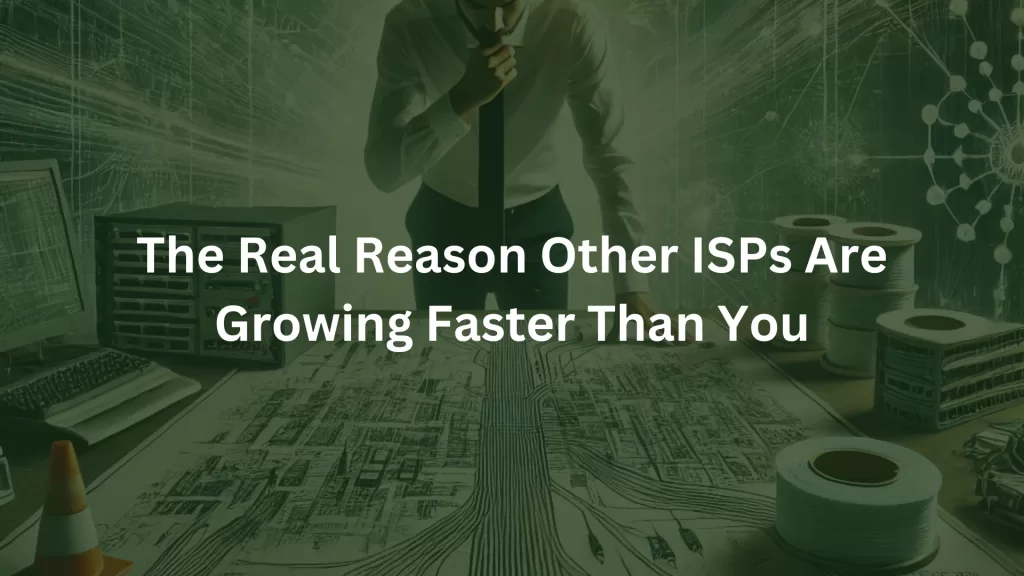
It’s 7:42 AM on a Tuesday, and you’re staring at the quarterly growth numbers on your desk. Something doesn’t add up. Your team is working harder than ever, you’ve invested in the latest fiber technology, and your prices are competitive. Yet somehow, the smaller ISP two counties over is growing at twice your rate.
“Maybe we need to spend more on marketing,” you think, reaching for your coffee. But deep down, you know that’s not it. You’ve already tripled your marketing budget this year, and while it moved the needle, it wasn’t the game-changer you expected.
Sound familiar? You’re not alone. I’ve sat in that same chair, looking at those same puzzling numbers, and I’ve seen this scenario play out across hundreds of ISPs and municipal networks across the country.
Here’s what nobody talks about at industry conferences: The real growth killer isn’t your technology, your prices, or even your competition. It’s your deployment strategy – or more specifically, the hidden inefficiencies that are quietly bleeding your resources dry.
The Million-Dollar Mistake Most ISPs Make
Let me tell you a story that might hit close to home. Last year, a mid-sized ISP in the Midwest (let’s call them “Midwest Fiber”) decided to accelerate their growth by launching three new service areas simultaneously. On paper, their plan looked solid: they had the capital, the technology, and eager customers waiting to sign up.
Six months later, they were in crisis mode. Their construction costs had ballooned 40% over budget, their timeline had doubled, and worst of all, they were losing potential customers to competitors who managed to deploy faster in adjacent areas. The kicker? Their internal analysis showed they were only utilizing 65% of their installed fiber capacity.
“But we followed industry best practices!” their CEO told me, frustration evident in his voice. And therein lies the problem – they were following a playbook that doesn’t work anymore.
Why Traditional Deployment Strategies Are Failing
Think of fiber deployment like playing chess. Most ISPs are playing checkers – making moves based on obvious opportunities and immediate returns. They:
- Deploy based on outdated demographic data
- Focus on dense areas without considering long-term expansion patterns
- Use a linear construction approach that maximizes short-term efficiency but creates long-term bottlenecks
- Underestimate the true cost of unused fiber capacity
The real numbers are sobering. Our industry analysis shows that the average ISP:
- Wastes 35% of their construction budget on inefficient routing and redundant work
- Loses 23% of potential customers during extended deployment delays
- Carries $150,000 in unused fiber capacity per mile of deployment
- Spends 2.8x more on customer acquisition in poorly planned deployment areas
And these are just the visible costs. The hidden ones are even more damaging:
- Board frustration with missed growth targets
- Team burnout from constant fire-fighting
- Eroding community trust when deadlines slip
- Competitors gaining footholds in your natural expansion areas
Breaking Down the Complex Reality
Think of fiber deployment like building a city. You wouldn’t start by building random houses wherever land is cheapest. You’d create a master plan that considers future growth, traffic patterns, and community needs.
Yet that’s exactly what many ISPs do – they build where it’s easiest, not where it makes the most strategic sense. It’s like building a house without considering where the roads will go.
Here’s what a smarter approach looks like, using a real example (with numbers changed to protect confidentiality):
A 50,000-home service area typically requires:
- 420 miles of fiber backbone
- 1,200 miles of distribution fiber
- 15 central office locations
- $42 million in construction costs
Traditional approach: Build out from existing infrastructure, focusing on high-density areas first. Result: 25% coverage in 18 months, 40% take rate, $2,800 cost per subscriber
Strategic approach: Build based on comprehensive network design that optimizes for both current density and future growth. Result: 40% coverage in 18 months, 55% take rate, $1,900 cost per subscriber
The Central State Utility Difference
This is where Central State Utility’s approach changes the game. Instead of just laying fiber, we help ISPs build intelligence into their deployment strategy from day one.
Take our recent project with a regional ISP facing similar challenges. By implementing our Strategic Network Development (SND) methodology, they:
- Reduced construction costs by 32%
- Increased their deployment speed by 45%
- Achieved a 60% take rate in new service areas
- Cut customer acquisition costs by 40%
How? By combining deep industry expertise with advanced planning tools that:
- Analyze current and future demand patterns
- Optimize construction routing for long-term efficiency
- Identify and eliminate potential bottlenecks before they occur
- Balance speed of deployment with strategic coverage
Your Next Move
The growth gap you’re seeing isn’t going to fix itself. Every month of delayed action means:
- Lost market share to more agile competitors
- Increased construction costs as material prices rise
- Missed revenue from potential customers
- Growing frustration from your board and team
But here’s the good news: you don’t have to figure this out alone. Central State Utility has helped dozens of ISPs just like yours transform their deployment strategy and accelerate their growth.
The question isn’t whether to optimize your deployment strategy – it’s whether you’ll do it before your competitors do. Because in five years, will you be looking back at 2025 as the year you transformed your growth trajectory, or the year you watched others pass you by?
Your legacy as a leader isn’t just about the network you build – it’s about the foundation you lay for your company’s future. Ready to take the first step?
